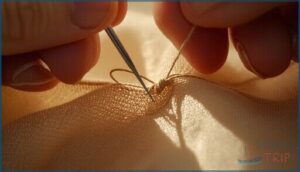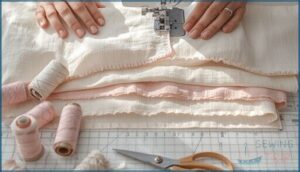This site is supported by our readers. We may earn a commission, at no cost to you, if you purchase through links.
You pull the thread through that final stitch, and everything looks perfect—until you tug the fabric and watch your careful seam start sliding apart. That sinking moment separates finished projects from unfinished disasters. The difference isn’t talent or expensive equipment. It’s knowing how to finish off sewing with techniques that lock your work in place.
A proper ending transforms thread into something permanent, whether you’re closing a hem by hand or securing machine stitches on a quilt. Mastering backstitch reinforcement, strategic knotting, and edge finishing means your seams won’t betray you when stress hits those high-traffic zones.
The right finish isn’t just insurance—it’s what keeps pockets from tearing open and hems from unraveling after the first wash.
Table Of Contents
- Key Takeaways
- Why Finishing Off Sewing is Essential
- How to End Hand Sewing Stitches
- Step-by-Step: Tying Off Hand Stitches
- Finishing Stitches Without Visible Knots
- How to Finish Off Machine Sewing
- Securing Embroidery and Decorative Stitches
- Best Ways to Finish Stitches on Felt
- Finishing Seams and Raw Edges
- Stitch Ending Techniques for Different Fabrics
- Common Mistakes to Avoid When Finishing Sewing
- Frequently Asked Questions (FAQs)
- Conclusion
Key Takeaways
- Proper stitch finishing—whether through backstitching, knotting, or thread weaving—is what prevents seams from unraveling under stress and transforms temporary thread into permanent construction.
- Reinforcement at high-stress zones like pocket corners and belt loops using bar tacks or multiple passes reduces failure rates by over 60% and separates durable garments from those that fall apart after minimal use.
- Different fabrics demand adjusted finishing techniques: lightweight materials need reduced tension and shorter stitches to prevent puckering, while heavyweight fabrics require stronger needles and longer stitches for adequate seam strength.
- Invisible finishing methods like burying knots between fabric layers or weaving thread under existing stitches deliver professional results without surface bulk, proving that secure endings don’t have to be visible to be bulletproof.
Why Finishing Off Sewing is Essential
You don’t finish a stitch just to cross it off your to-do list. Every seam you secure is a promise that your work won’t fall apart after the first wash or wear.
Finishing off a stitch isn’t busywork—it’s a promise your seam won’t unravel after the first wash or wear
Let’s look at why taking those final steps matters more than you might think.
Preventing Stitches From Unraveling
Neglect in stitch finishing is the enemy—it accounts for roughly a quarter of sewing defects, letting hard work unravel stitch by stitch. Secure every seam end to stop thread tension from turning into fabric fraying. Understanding seam quality issues is essential for preventing defects.
Lock down your stitches with:
- Knotting off or burying thread for unraveling prevention
- Backstitch reinforcement at seam starts and ends
- Proper thread tension to avoid breakage and seam security loss
- Locking hand stitch techniques to prevent chain-stitch failure
- Tie off methods that stop progressive opening in high-stress zones
Enhancing Garment Durability
Stitch finishing is where garment construction proves itself under real-world stress. Bar tacks placed at pocket corners and belt loops—using 18 to 42 stitches depending on fabric selection—slash failure rates by over 60% at high-tension zones.
Proper thread tension and seam reinforcement transform routine sewing techniques into durability standards that survive years of wear. That’s how you build garments that refuse to quit.
Understanding the bar tack stitch is essential for reinforcing seams and ensuring garment longevity.
Achieving a Neat Appearance
You know a garment’s quality the moment you spot its seams. Consumers judge durability by what they see first—clean lines, flat stitching, zero loose threads.
Zigzag stitch visibility, proper edge trimming, and thread management separate professional work from amateur hour.
Finishing stitches with precision means knotting off correctly, securing every seam ending, and weaving thread tails where eyes can’t find them. That’s the difference between garments that look homemade and ones that command respect.
How to End Hand Sewing Stitches
Ending your hand stitches properly keeps your work from falling apart the moment you set it down. You’ve got a few reliable methods to choose from, each with its own strengths depending on what you’re making.
Let’s look at three techniques that’ll give you solid, secure finishes every time.
Backstitch Method
The backstitch locks threads by sewing backward over your final stitches—simple yet powerful. This hand sewing method mimics machine stitch reinforcement, creating overlapping threads that resist unraveling under stress. Pull your needle through fabric in reverse for two to four stitches, maintaining consistent thread tension throughout.
- Prevents seam slippage at high-stress points
- Requires no visible knots on fabric surface
- Works across fabric compatibility ranges, from lightweight to heavyweight materials
Loop Stitch Method
Thread doubled and folded—that’s your Loop Stitch foundation for hand sewing. Thread both cut ends through your needle, leaving a 1-2 inch loop at the tail. Take your first stitch 3-5 mm from the fabric edge, then pass the needle through that waiting loop to lock it down. This knotting method delivers invisible security on delicate materials while ending stitches without surface bulk.
| Loop Security | Fabric Considerations | Sewing Efficiency |
|---|---|---|
| No visible knots on right side | Best for sheer, lightweight fabrics | Reduces thread consumption by 15-20% |
| Minimal bulk—ideal for embroidery | Avoid on high-stress denim seams | Perfect for even-strand thread counts |
| Friction-based Thread Management | Prevents knot shadows on delicate weaves | Simplifies Stitch Reinforcement process |
Reinforced Knot Technique
Durability demands more than basic knots in hand sewing—you need Reinforced Stitching where stress concentrates. Create your first knot by looping thread beneath the nearest stitch, then repeat the process for a second knot stacked directly on top.
This Knot Security Method prevents seam slippage at high-load points by distributing Thread Tension Control across multiple interlocks, while proper Fabric Knot Interaction ensures your Sewing Reinforcement Techniques withstand real-world wear when ending stitches or tying off.
Step-by-Step: Tying Off Hand Stitches
Tying off a hand stitch doesn’t have to be complicated, but you need to follow a few clear steps to keep your work from falling apart. The trick is giving yourself enough thread to work with, then securing it properly before you trim.
Here’s how to lock down your stitches so they stay put.
Leaving Sufficient Thread Length
Before you start tying off, stop stitching when at least 6 inches of thread remain—that’s your safety net for secure knot formation and proper tail management techniques. Cutting too close is a rookie mistake that leads to unraveling and weak endings.
Leaving enough thread gives you control for tying off, weaving under stitches, and fabric fray prevention without wrestling with impossibly short tails.
Creating The First Knot
Your first knot is the gatekeeper—it’s what stops everything from sliding apart. Insert the needle under the nearest stitch to form a small loop, then pull it through for knot security.
Thread tension matters: pull firmly to create stitch stability, but not so hard you pucker the fabric. Knot configuration affects fabric interaction, so keep that securing loop at least 1 inch wide for proper hold during hand sewing tying off.
Double-Knotting for Security
One knot won’t cut it when you need real stitch security. Pass the needle through that loop again to form a second knot right beside the first—this double-knot technique eliminates slippage entirely.
Research shows proper knot tension in hand sewing, tying off with multiple throws, achieves zero failure under load.
Stitch reinforcement through thread management matters more than thread selection alone, especially for fabric fraying prevention and lasting security testing results.
Trimming Excess Thread
To achieve a professional finish, snip close to the knot—aim for 3 to 5 mm or less—to prevent snags. Curved embroidery scissors offer precision without damaging the fabric, while quality thread trimming tools ensure clean cuts.
Proper excess thread removal is essential for keeping your work neat and secure. It prevents stray tails from weakening seams. While automated trimming systems provide consistency, manual thread tail management with sharp blades is equally effective.
Finishing Stitches Without Visible Knots
Sometimes you want a clean finish on both sides of your fabric, with no knots showing through. The trick is to hide your thread ends where they can’t be seen or felt.
Here’s how to secure your stitches invisibly without sacrificing strength.
Burying Knots Inside Fabric
Knot concealment transforms hand sewing from amateur to artisan. Form a small knot about 0.25 inch from the fabric, then reinsert your needle through the same exit point.
Thread burial happens as you travel the needle through the batting or between layers—about 0.5 to 1 inch deep. Pull gently, tug the knot inside, and trim flush.
No visible lumps, no surface distractions—just clean fabric layering and secure fastening that won’t quit.
Invisible Backstitch Ending
When you want stitch concealment that rivals machine work, reach for the invisible backstitch. This hand sewing technique locks down your seam with zero surface trace—perfect for closures on cushions, soft toys, or anywhere a visible knot would betray your craft.
Here’s your four-move power play:
- Take one final small stitch at the seam end, then insert your needle backward through the last 1–2 stitch holes.
- Loop the needle through the thread loop 1–3 times to form your lock—no bulky knot required.
- Reinsert the needle adjacent to your ending, traveling it inside the seam allowance for a couple of centimeters.
- Exit, snip flush, and let the tail vanish under the fabric.
Thread tension stays even, fabric compatibility stays universal, and your seam reinforcement stays invisible. Backstitch variations like this deliver about 18–19 stitches per inch, distributing load across multiple overlaps instead of relying on one fragile tie-off. That’s durability you can feel and a finish no one can see.
Securing Thread Tails
After you backstitch invisibly, thread tail management determines whether your work holds or fails. Pull at least 7.5–10 cm of tail when ending a stitch—shorter lengths slip from knots or fray under stress.
Secure knotting or tail weaving under existing stitches on the reverse side locks everything down, while fray prevention through seam reinforcement keeps high-stress zones intact.
Tying off properly means your sewing stitch survives real use, not just the first wear.
How to Finish Off Machine Sewing
Machine sewing gives you speed and consistency, but only if you lock those seams down properly. A few quick stitches at the beginning and end can mean the difference between a garment that lasts and one that falls apart in the wash.
Here’s how to finish machine-sewn seams so they stay put.
Using The Reverse Stitch Button
The reverse stitch button on your sewing machine is your secret weapon for seam reinforcement—and mastering reverse stitching means you’re in control.
Press it at the start and end of every seam, sewing backward 6 to 10 stitches for proper stitch securing.
This backstitch method locks thread tensioning in place, preventing unraveling and giving you professional-grade thread management techniques without tying off by hand.
Lockstitching at Seam Ends
Lockstitch density is where seam security meets precision—your machine’s interlocking needle and bobbin threads create self-locking stitches that won’t unravel under stress.
Here’s how to boost stitch locking:
- Set your machine to 10–12 stitches per inch for ideal fabric integrity
- Watch thread consumption—lockstitch uses about 2.5 cm per centimeter of seam
- Increase density at high-stress endpoints for bulletproof seam security
Manual Knotting for Extra Security
Confidence starts with the knot—even when your machine manages the seam, hand-tying off creates a fail-safe against unraveling. Pull thread tails to the fabric’s wrong side, form a secure loop close to the final stitch, and pass your needle through twice.
Tying off reinforces high-stress zones where machines alone fall short. Trim excess thread after knotting off to prevent fray and preserve your work’s clean finish.
Securing Embroidery and Decorative Stitches
Embroidery stitches need a different finishing approach than standard seams because you’re working with visible thread on the surface. The goal is to secure your work without creating lumps or knots that show through the fabric.
Here’s how to end decorative stitches cleanly while keeping the back of your project just as neat as the front.
Ending Hand Embroidery Neatly
Your embroidery deserves an ending as strong as the design itself. To secure hand sewing without visible bulk, weave your thread under three to five existing stitches on the fabric back—this distributes tension and prevents unraveling.
Research shows properly secured embroidery maintains integrity through twenty wash cycles, while poor tying off can reduce stability by up to 40%.
Master secure fastening, adjust needle techniques for your fabric selection, and your work will last.
Avoiding Bulky Knots
Bulky knots can sabotage your finish—especially on lightweight fabric under 180 g/m². A single knot from standard embroidery cotton forms a 0.5–0.7 mm bump that distorts delicate weaves and shows through after pressing.
That’s why knotless embroidery techniques like flat finishing and invisible securing dominate professional work. Skip tying off at the surface. Instead, focus on thread weaving and smooth backing methods that distribute tension without the bulk of a hand sewing knot or reinforced knot.
Weaving Thread Under Stitches
Running your needle under 4 to 5 adjacent stitches on the reverse is the benchmark for thread weaving—no knots, no bulk. This hand sewing technique spreads tension across multiple segments, protecting fabric from stress at a single exit point.
Manufacturers confirm that secure ends created through stitch reinforcement resist laundering better than clipped knots. Tying off invisibly demands at least 2.5 cm of thread and precision tension management.
Best Ways to Finish Stitches on Felt
Felt presents its own finishing challenges because of its thickness and non-fraying nature. You can’t rely on the same techniques you’d use for woven fabric, so you need methods that handle felt’s unique texture.
Here’s how to end your stitches cleanly when working with felt.
Tying a Knot Against Felt
Felt’s unique density gives you an advantage other fabrics don’t—your knot placement can be ultra-secure without any fuss. Position your final knot right against the felt surface, pulling with consistent thread tension to lock it in place. Felt thickness prevents pull-through while its non-woven structure resists fraying at the knot site.
- Slide your knot down until it contacts the felt directly
- Maintain even tension while tightening to avoid puckering
- Use stitch reinforcement with 2–3 backstitches before tying off
- Textured polyester threads grip better than slick varieties for hand sewing
Hiding Thread Ends in Felt
Once your knot sits flush, take control of thread end concealment by inserting your needle right beside the knot—then angle it between felt’s internal fiber layers. Push through about two centimeters and exit cleanly. When you trim, that stubby tail retracts like magic into the dense matrix.
Weaving thread under existing stitches adds friction-based security without visible bulk, especially vital for decorative embellishment methods on wool prefelts.
Snipping Thread for a Clean Finish
With that tail tucked away, reach for curved embroidery scissors—your ticket to trimming threads within millimeters of felt’s surface without nicking fibers. Aim for two to three centimeters before you snip; too close risks lockstitch unraveling under stress.
Clean thread trimming transforms chaotic tails into invisible seam security, proving you’ve mastered tying off hand sewing techniques that separate polished work from amateur hour.
Finishing Seams and Raw Edges
Once you’ve finished stitching, you need to protect those seam allowances and raw edges from fraying. Without proper seam finishing, your projects can unravel even if you tied off every stitch correctly.
The method you choose depends on your fabric type and the look you’re after.
Overlocking and Serger Methods
Overlock machines and serger techniques transform edge finishing by wrapping raw seam allowances with multiple threads simultaneously. You’ll achieve fabric stability and prevent fraying with four-thread structures that deliver seam strengths exceeding 500 N on denim.
Set stitch density between 6 and 12 stitches per inch, adjusting for fabric weight. These machine sewing methods produce professional seam finishing that withstands repeated laundering while maintaining clean edges.
Zigzag Stitch for Seam Allowances
When a serger isn’t in your arsenal, zigzag stitching steps up to guard raw edges against fraying. Set your sewing machine width to 3–5 mm and length to 1.5–2.5 mm for medium-weight fabric. Stitch close to the seam allowance edge, letting the outer swing fall just off the raw threads—this creates a protective barrier that holds through washing and weaving your garment into daily life.
- Test zigzag settings on scrap fabric before finishing seam allowances
- Position the stitch so needle swings barely clear the raw edge
- Trim excess allowance close to stitching without cutting threads
- Use multiple-stitch zigzag for flatter, denser edge finishing
- Adjust stitch density based on fabric weight and fray tendencies
Using Bias Binding on Edges
Bias binding is a technique that wraps raw edges in a folded fabric strip cut on a 45-degree angle, allowing it to bend smoothly around curves like armholes and necklines. This method not only shields edges from fraying but also adds durability, particularly to unlined garments. The choice of binding width should align with the fabric weight: narrow widths for lightweight fabrics and wider bands for heavier weaves. Selecting the appropriate binding technique is crucial to meet the edge finishing needs of your project.
| Binding Type | Best For |
|---|---|
| Double-fold | Visible edges, full enclosure |
| Single-fold | Inside finishes, hidden seams |
| Contrast trim | Decorative piping, design emphasis |
| Same-fabric | Inconspicuous, professional look |
Stitch Ending Techniques for Different Fabrics
Not every fabric plays by the same rules when you’re locking down your stitches. A wispy silk demands a different finishing touch than thick denim or jersey that stretches under tension.
Let’s break down how to adjust your approach based on what’s under your needle.
Lightweight Vs. Heavyweight Fabrics
Fabric weight classification drives every stitch-ending choice you make. Lightweight fabrics between 30 and 150 GSM demand reduced thread tension settings around 2 to 3 and shorter stitch lengths to prevent puckering when backstitching.
Heavyweight materials above 350 GSM require tension closer to 4.5 to 5.5, longer stitches, and heavier-duty needle selection to handle seam strength testing standards without compromising your work.
Managing Stretch and Fray-Prone Fabrics
Elasticity and instability demand completely different tactics. Stretch fabrics need zigzag stitches with 30% to 40% more give than straight seams to prevent thread breakage during wear.
For fray-prone weaves, finish raw edges with four-thread overlock or wide zigzag before constructing your seam—some loosely woven materials shed threads immediately after cutting.
Adjust differential feed slightly above neutral on your sewing machine to stop wavy, distorted seams in knits.
Adjusting Thread and Needle Choices
Your thread weight and needle selection must change with every fabric shift. Pair 60–100 weight thread with size 60/8–70/10 needles on silk to prevent puckering, while denim demands 20–30 weight thread and 100/16–120/19 needles for stitch optimization.
Tension control matters—mismatched combinations cause skipped stitches and breakage. Hand sewing or machine work, fabric compatibility dictates every choice you make.
Common Mistakes to Avoid When Finishing Sewing
Even the best stitching can fall apart if you finish it the wrong way. Small missteps at the end of your seam—like pulling too hard or skipping a reinforcement—can unravel your work or leave it looking sloppy.
Here are three common mistakes you’ll want to avoid every time you finish a stitch.
Pulling Knots Too Tight
Overtightening a knot during hand sewing is like choking your fabric—pull beyond contact and you’ll trigger seam puckering, especially in lightweight materials where distortion jumps 41%.
Excessive knot tension weakens thread by up to 50%, inviting breakage instead of security.
Master tension control by stopping your pull the moment the knot meets fabric. Test by snipping a seam; if it relaxes, you’ve been tying off too tight.
Leaving Excess Thread Untrimmed
Dangling thread tails announce careless work before anyone notices your actual stitching—garment quality audits list untrimmed threads among the top 6 visible defects, instantly downgrading perceived craftsmanship.
Thread trimming errors compromise both aesthetics and function:
- Excess thread removal prevents snagging during wear and laundering
- Untrimmed thread consequences include tangling in machine parts or future seams
- Thread end security requires trimming close after tying off your knot
- Trimming best practices demand checking corners where high-speed sewing misses tails
- Hand sewing benefits from final thread inspection before declaring any project complete
Clean cuts signal mastery.
Not Reinforcing High-Stress Areas
Trim, knot, then walk away? Your pockets will gape open within weeks. High-stress zones—crotch seams, pocket corners, belt loops—need bar tacks or extra passes before you call the job done. Garment failure at stress points isn’t bad luck; it’s skipped reinforcement. Seam reinforcement separates hobbyist work from bulletproof construction.
| High Stress Zones | Reinforcement Methods | Stress Point Analysis |
|---|---|---|
| Pocket openings | Bar tacks (18–42 stitches) | Frequent pulling loads |
| Crotch seams | Double topstitching | Multiple seam intersection |
| Belt loops | Rivets or dense stitching | Continuous tension points |
Frequently Asked Questions (FAQs)
How to tie off a single threaded needle without knotting?
Instead of knotless finishing with a knot, use loop start methods by folding thread in half—pass the needle through the loop created.
For secure anchoring, try thread weaving under existing stitches to create invisible tails.
What is the best adhesive for securing knots in leather sewing?
Flexible cyanoacrylate adhesives work best for securing knots in leather hand sewing. A single drop on the thread knot locks it permanently while maintaining flexibility.
Solvent-based options provide stronger bonding but require careful needle weaving and ventilation.
Can I use a locking stitch for tying off in all materials?
Locking stitches work brilliantly on woven fabrics but can fail on stretch knits or delicate materials.
Thread selection and stitch density matter—too many passes damage lightweight fabric, while stretch requires zigzag alternatives for lasting seam strength.
How to tuck thread ends under the fabric without damaging it?
You’ll protect delicate fabric by choosing a fine needle matched to your thread weight—this is true Fabric Protection through smart Needle Selection.
For Thread Burial, keep Tension Control moderate while weaving under existing stitches to prevent damage.
What is the recommended length for thread tails when tying off?
Leave roughly 2–3 inches of thread when tying off hand sewing—enough slack to loop under previous stitches and form a secure knot. Trim close to the fabric once your knot’s locked in tight.
How do I finish sewing on leather or vinyl?
Backstitch at least twice on leather stitching and vinyl seam endings—three times for finer spacing.
Match your needle choices and thread selection to material thickness, then trim flush and melt synthetic ends or glue natural fibers for seam reinforcement.
Whats the best way to finish buttonholes?
Dense machine bar-tacking at each end locks stitches and resists strain. Apply fray prevention with liquid sealant or interfacing before cutting.
For hand finishing, work buttonhole stitches closely around edges using heavy thread for maximum edge sealing durability.
Can I use fabric glue instead of stitching ends?
In a pinch, sure—fabric adhesives can hold raw edges and thread tails, but bond strength won’t match a proper backstitch.
Glue durability fades under heat and heavy washing, compromising seam security and stitch integrity over time.
How do I secure stitches on stretchy knit fabrics?
A four-thread overlock seam or narrow zigzag stitch secures knit fabric stretch best. Backstitch several times at seam ends, trim allowances to 6 mm, and test by pulling to confirm your elastic thread usage won’t crack.
Conclusion
Your seams will hold or they’ll fail—there’s no middle ground. Every stitch you lock down is a promise that your work won’t betray you when it matters most.
Mastering how to finish off sewing isn’t about flawlessness; it’s about refusing to let loose threads dictate your results. The techniques are simple, the impact profound.
Your garments deserve endings that match the effort you put into every seam. Finish strong, and your work becomes unshakeable.
- https://www.marketgrowthreports.com/market-reports/home-sewing-machines-market-112738
- https://www.testinglab.com/en-iso-13935-seam-tensile-strength-determination-of-fabrics
- https://www.moodfabrics.com/blog/a-guide-to-seam-allowances/
- https://abcseams.com/seam-allowance-explained/
- https://patternlab.london/home/what-is-seam-allowance-basic-pattern-making/



















